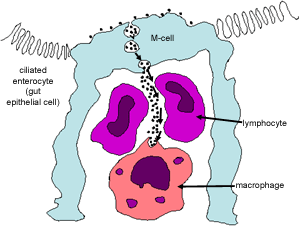This is a section through part of the ileum, can you identify the Peyer's patches?
The mucosa of the digestive, respiratory and urinary tracts often
contains small aggregations of lymphocytes called lymphoid follicles.
These are called 'Mucosa associated lymphoid tissue' (MALT).
In some cases, these aggregations are large, and confluent. This
happens in the tonsils, peyers patches
and the appendix.
Peyers patches mostly contain T-cells, but also can have germinal
centres that contain B-lymphocytes, as well as macrophages.
Peyer's patches to not have any afferent lymphatics. The activated
lymphocytes pass out in efferent lymphatics and travel to the lymph nodes.

This shows a diagramatic representation of an M-cell, and its function.
The epithelium of the mucosa contains special flat epithelial
cells called M (membrane-like) cells or FAE (follicle associated
epithelial cells). These specialised cells take up small amounts
of gut antigens entering the gut lumen, and pass them onto antigen
presenting cells, and lymphocytes of the MALT. Diffuse B-lymphocytes
in gut react to micro-organisms that cross the mucosa, and they
make IgA type antibodies, which are then secreted directly onto
the gut lumen. These antibodies help to prevent micro-organisms
in the gut from sticking to the gut epithelium, and can neutralise
toxins and viruses.
